

Paper Folding - Number Sense, Shape and Space. This is a Youcubed favorite.
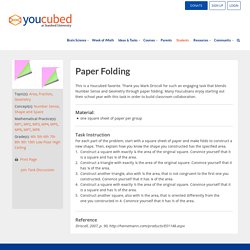
Thank you Mark Driscoll for such an engaging task that blends Number Sense and Geometry through paper folding. Many Youcubians enjoy starting out their school year with this task in order to build classroom collaboration. Material: one square sheet of paper per group Task Instruction For each part of the problem, start with a square sheet of paper and make folds to construct a new shape. Reference. Grades 6-8. Build a Portable Sundial Posted on March 9th, 2016 by Mary Lord Students in grades 6 to 8 investigate the accuracy of sundials and the discrepancy that lies between “real time” and “clock time.”
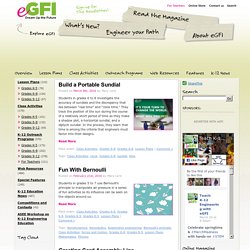
They track the position of the sun during the course of a relatively short period of time as they make a shadow plot, a horizontal sundial, and a diptych sundial. In the process, they learn that time is among the criteria that engineers must factor into their designs. Read More. Light Your Way (for Informal Learning) - Sprinkle - www.TeachEngineering.org. Discover Engineering. Grade Level Middle School, 5th-8th Related classroom topics Civil Engineering, Force, Structure Supplies Needed Divide students into groups of s3-5. 1 marbleBalloon3 strawsTape30 feet of string or threadLarge rubber band2 paper clipsSquare of cardboardScissorsPiece of cloth Procedure 1.
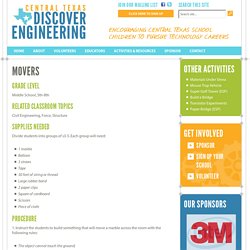
The object cannot touch the ground;The object cannot be moved across the room by a person (no throwing);Only use the materials given. 2. 3. Discover Engineering. Grade Level Middle School, 5th-8th Related classroom topics Problem Solving, General Engineering, Mathematics Supplies Needed.
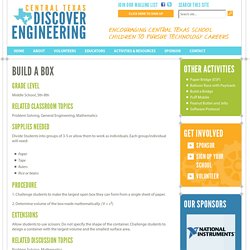
Architects and Engineers. Summary Students explore the interface between architecture and engineering.
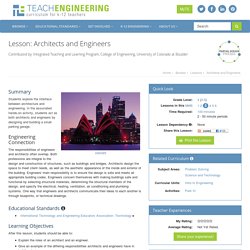
In the associated hands-on activity, students act as both architects and engineers by designing and building a small parking garage. Engineering Connection The responsibilities of engineers and architects often overlap. Environmental Engineering - Curricular Unit - www.TeachEngineering.org. Each TeachEngineering lesson or activity is correlated to one or more K-12 science, technology, engineering or math (STEM) educational standards.

All 100,000+ K-12 STEM standards covered in TeachEngineering are collected, maintained and packaged by the Achievement Standard Network (ASN), a project of JES & Co. (www.jesandco.org). In the ASN, standards are hierarchically structured: first by source; e.g., by state; within source by type; e.g., science or mathematics; within type by subtype, then by grade, etc. Click on the standard groupings to explore this hierarchy as it applies to this document. Integrated Teaching and Learning Program, College of Engineering, University of Colorado Boulder The contents of these digital library curricula were developed under grants from the Fund for the Improvement of Postsecondary Education (FIPSE), U.S. Earthquake in the Classroom. Summary Students learn how engineers construct buildings to withstand damage from earthquakes by building their own structures with toothpicks and marshmallows.
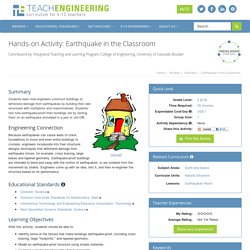
Students test how earthquake-proof their buildings are by testing them on an earthquake simulated in a pan of Jell-O®. Engineering Connection Because earthquakes can cause walls to crack, foundations to move and even entire buildings to crumple, engineers incorporate into their structural designs techniques that withstand damage from earthquake forces, for example, cross bracing, large bases and tapered geometry. Earthquake-proof buildings are intended to bend and sway with the motion of earthquakes, or are isolated from the movement by sliders. Disaster-Proof Housing. Lesson courtesy of ProjectEngin CEO Ann Kaiser, an experienced engineer and educator who presented this at ASEE’s 2015 annual K-12 Engineering Workshop in Seattle.
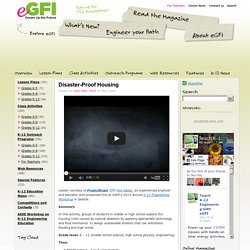
Summary In this activity, groups of students in middle or high school explore the housing crisis caused by natural disasters by applying appropriate technology and fluid mechanics to design sustainable shelters that can withstand flooding and high winds. Grade level: 6 – 12 (middle school science; high school physics; engineering) Time: Middle school – 4 to 6 class periodsPhysics course – 3 to 5 class periodsEngineering course – 10 to 12 classes. File. Njit_paper_activity1_engineering_design_process.pdf. Workshop Guide 2014.pdf. Projects. Electronics for Education: Hands-on STEM Lessons. 3rd Grade Engineering Projects: a lesson with littleBits. Time for Design. Summary Students are introduced to the engineering design process, focusing on the concept of brainstorming design alternatives.
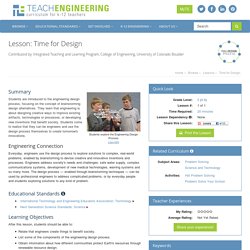
They learn that engineering is about designing creative ways to improve existing artifacts, technologies or processes, or developing new inventions that benefit society. Edible Rovers. Summary Students act as Mars exploratory rover engineers.
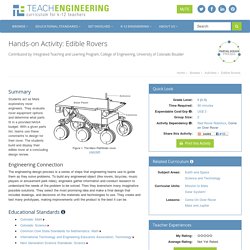
They evaluate rover equipment options and determine what parts fit in a provided NASA budget. With a given parts list, teams use these constraints to design for their rover. The students build and display their edible rover at a concluding design review. Fancy Feet. Summary Students use the engineering design process to solve a real-world problem — shoe engineering! Working in small teams, students design, build and test a pair of wearable platform or high-heeled shoes, taking into consideration the stress and strain forces that it will encounter from the shoe wearer.
They conclude the activity with a "walk-off" to test their shoe designs and discuss the design process. Cub_intro_lesson01_activity1_brainstorming.docx. Splash, Pop, Fizz: Rube Goldberg Machines. Summary Refreshed with an understanding of the six simple machines; screw, wedge, pully, incline plane, wheel and axle, and lever, student groups receive materials and an allotted amount of time to act as mechanical engineers to design and create machines that can complete specified tasks.
For the competition, they choose from pre-determined goal options such as: 1) dumping goldfish into a bowl, 2) popping a balloon, or 3) dropping mint candies into soda pop (creating a fizzy reaction). Students demonstrate their functioning contraptions to the class, earning points for using all six simple machines, successful transitions from one chain reaction to the next, and completion of the end goal.
Paper Drop Design Competition. Summary Using paper, paper clips and tape, student teams design flying/falling devices to stay in the air as long as possible and land as close as possible to a given target. Student teams use the steps of the engineering design process to guide them through the initial conception, evaluation, testing and re-design stages. The activity culminates with a classroom competition and scoring to evaluate how each team's design performed. Njit_paper_activity1_engineering_design_process.pdf.
The Universal Language of Engineering Drawings. Summary Students practice the ability to produce clear, complete, accurate and detailed design drawings through an engineering design challenge. Using only the specified materials, teams are challenged to draw a design for a wind-powered car. Cub_engrdrawings_activity1_engrdrawsurvey_draft2_tedl_dwc.pdf.